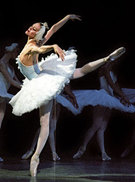 _I was lucky enough to get tickets to see the Moscow City Ballet's production of 'Swan Lake' at Venue Cymru in Llandudno earlier this week. This production has become a 'must see' for all those who dipped their toes into ballet after seeing 'Black Swan' in the cinemas last year, but has been high up on my list for a long time. Swan Lake follows the love story of a prince who is entranced by Odette - a beautiful maiden trapped in the body of a graceful swan by an evil sorcerer - and her nemesis, Odile the black swan. Swan Lake was fantastic - the sheer grace and beauty of the dancers as they effortlessly leapt about the stage, lithe-limbed and ethereal. It was amazing to see how they managed to transform themselves from human to swan, simply by changing the movement of an arm or leg. What was even more impressive was the way that they managed to make it look completely effortless - and yet ballet has to be one of the hardest forms of exercise. Dancers have to be incredibly fit; strong and supple with immense stamina to be able to perform for 2-3 hours every evening, in addition to hours of practice and rehearsal during the day. I think that dance, and in particular ballet, must work pretty much every muscle in the body and relies on very good 'core stability'. A lot of dancers practice Pilates to keep these core muscles strong; one of the best workout DVD's I use is Darcey Bussell's 'Pilates for Life' (Darcey was a prima ballerina with the Royal Ballet for many years) and many of the exercises I prescribe for patients are based on Pilates. Obviously, chiropractic is used extensively within the ballet world - most of the big dance companies have their own chiropractor as part of the medical team - and I'm sure those that have seen 'Black Swan' will remember the scene where she has her foot and ankle manipulated with an almighty 'crack'! Seeing Swan Lake has once again shown me how impressive the human body can be, and has rekindled my passion for ballet. I danced for many years as a child, but have recently taken it up again at the Barton Dance and Drama Academy in Holyhead. There is nothing that stretches the mind and the body quite like a hard session at the barre - and who knows, maybe one day I'll realise my dream of being a ballerina!
0 Comments
|
Ceri AnnEich Ceiropractydd yng Nghlinig Ceiropracteg Llangefnii Blogumulus by Roy Tanck and Amanda Fazani
Archives
June 2020
|
Llangefni Chiropractic Clinic, 6 GlanHwfa Rd, Llangefni LL777EN, Anglesey, North Wales, UK privacy policy Llangefni Chiropractic Clinic 2020
 RSS Feed
RSS Feed



